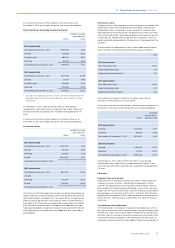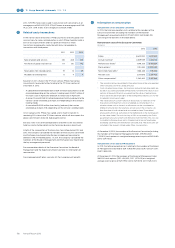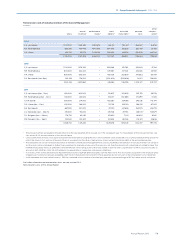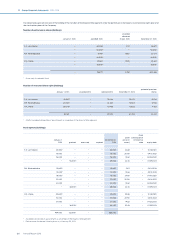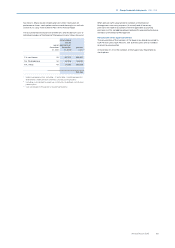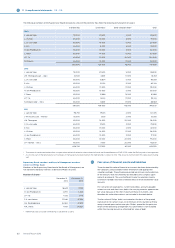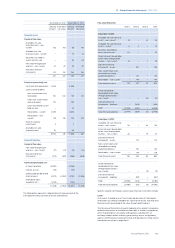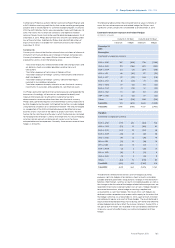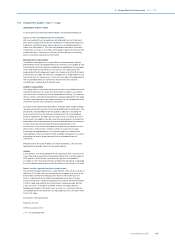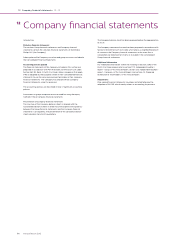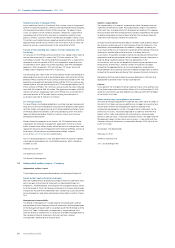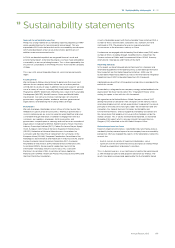Philips 2013 Annual Report Download - page 187
Download and view the complete annual report
Please find page 187 of the 2013 Philips annual report below. You can navigate through the pages in the report by either clicking on the pages listed below, or by using the keyword search tool below to find specific information within the annual report.
11 Group financial statements 11.9 - 11.9 36
Annual Report 2013 187
institutions with respect to financial derivative instruments. Philips actively
manages concentration risk and on a daily basis measures the potential
loss under certain stress scenarios, should a financial institution default.
These worst-case scenario losses are monitored and limited by the
Company.
The Company does not enter into any financial derivative instruments to
protect against default by financial institutions. However, where possible
the Company requires all financial institutions with whom it deals in
derivative transactions to complete legally enforceable netting
agreements under an International Swap Dealers Association master
agreement or otherwise prior to trading, and whenever possible, to have a
strong credit rating from Standard & Poor’s and Moody’s Investor Services.
Philips also regularly monitors the development of the credit risk of its
financial counterparties. Wherever possible, cash is invested and financial
transactions are concluded with financial institutions with strong credit
ratings or with governments or government-backed institutions.
Below table shows the credit ratings of the financial institutions with which
Philips had short-term deposits above EUR 25 million as of December 31,
2013:
Credit risk with number of counterparties
for deposits above EUR 25 million
25-100
million
100-500
million
500-2,000
million
AA-rated governments − 2 −
AA-rated government banks − 1 −
AAA-rated bank counterparties − − −
AA-rated bank counterparties 1 2 −
A-rated bank counterparties 1 3 −
2 8 −
For an overview of the overall maximum credit exposure of the group’s
financial assets, please refer to note 34, Fair value of financial assets and
liabilities for details of carrying amounts and fair value.
Country risk
Country risk is the risk that political, legal, or economic developments in a
single country could adversely impact our performance. The country risk
per country is defined as the sum of the equity of all subsidiaries and
associated companies in country cross-border transactions, such as
intercompany loans, accounts receivable from third parties and
intercompany accounts receivable. The country risk is monitored on a
regular basis.
As of December 31, 2013, the Company had country risk exposure of EUR
7.8 billion in the United States, EUR 2.5 billion in Belgium and EUR 1.5
billion in China (including Hong Kong). Other countries higher than EUR
500 million are United Kingdom (EUR 673 million), Japan (EUR 608
million) and the Netherlands (EUR 517 million). Countries where the risk
exceeded EUR 300 million but was less than EUR 500 million are Poland,
Germany and Malaysia. The degree of risk of a country is taken into
account when new investments are considered. The Company does not,
however, use financial derivative instruments to hedge country risk.
Other insurable risks
Philips is covered for a broad range of losses by global insurance policies
in the areas of property damage/business interruption, general and
product liability, transport, directors’ and officers’ liability, employment
practice liability, crime, and aviation product liability. The counterparty risk
related to the insurance companies participating in the above mentioned
global insurance policies are actively managed. As a rule Philips only
selects insurance companies with a S&P credit rating of at least A-.
Throughout the year the counterparty risk is monitored on a regular basis.
To lower exposures and to avoid potential losses, Philips has a global Risk
Engineering program in place. The main focus of this program is on
property damage and business interruption risks including company
interdependencies. Regular on-site assessments take place at Philips
locations and business critical suppliers by risk engineers of the insurer in
order to provide an accurate assessment of the potential loss and its
impact. The results of these assessments are shared across the Company’s
stakeholders. On-site assessments are carried out against the predefined
Risk Engineering standards which are agreed between Philips and the
insurers. Recommendations are made in a Risk Improvement report and
are monitored centrally. This is the basis for decision-making by the local
management of the business as to which recommendations will be
implemented.
For all policies, deductibles are in place, which vary from EUR 250,000 to
EUR 2,500,000 per occurrence and this variance is designed to
dierentiate between the existing risk categories within Philips. Above this
first layer of working deductibles, Philips operates its own re-insurance
captive, which during 2013 retained EUR 2.5 million per occurrence for
property damage and business interruption losses and EUR 5 million in the
aggregate per year. For general and product liability claims, the captive
retained EUR 1.5 million per claim and EUR 6 million in the aggregate. New
contracts were signed on December 31, 2013, for the coming year, whereby
the re-insurance captive retentions remained unchanged.
36 Subsequent events
Dutch pension plan contribution
On July 1, 2013, Philips announced that it had reached an agreement with
the Dutch trade unions on a new collective labor agreement that covers
the period January 1, 2013 till December 31, 2014. The new agreement
includes changes in the plan rules and the funding agreement with the
Dutch pension plan, which is the company’s largest Defined Benefit
pension plan. The plan changes have become eective as of January 1,
2014 and the new funding agreement has been signed by the Trustees of
the Dutch pension plan. As part of these changes, Philips agreed to make a
EUR 600 million contribution to the Dutch pension plan, of which EUR 240
million has been settled in cash on February 19, 2014. During 2014 and
2015, the remainder of the consideration will be settled through the
transfer of assets and cash proceeds from the sale of assets which are
currently owned by Philips. The (majority of the) contribution will need to
be written o through other comprehensive income due to the asset
ceiling restrictions in the plan.
Healthcare facility in Cleveland, Ohio
In our healthcare facility in Cleveland, Ohio, certain issues in the general
area of manufacturing process controls were identified during an ongoing
US Food and Drug Administration (FDA) inspection. To address these
issues, on January 10, 2014 we started a voluntary, temporary suspension
of new production at the facility, primarily to strengthen manufacturing
process controls. Currently, there is no indication of product safety issues.
This action is estimated to have a negative impact on the sector’s
operational results of approximately EUR 60 to 70 million in the first half of
2014, of which we expect to recover a substantial part in the second half of
2014.
Transfer of the remaining 30%-stake in TP Vision Holding to TPV
Technology Limited (TPV)
On January 20, 2014 Philips announced that it has signed a term sheet to
transfer the remaining 30% stake in the TP Vision venture to TPV
Technology Limited. The signing of definitive agreements is expected to
take place in the first quarter of 2014, with completion expected in the
second half of 2014, subject to certain regulatory and TPV shareholder
approvals. After completion, TPV will fully own TP Vision, which will
enable further integration with TPV’s TV business.
The remaining 30% stake in the TP Vision venture will be transferred for a
deferred purchase price and all outstanding loans and stand-by facilities
between Philips and the TP Vision venture will be transferred to TPV. The
brand license agreement between Philips and the TP Vision venture will
remain in place, with an annual royalty of 2.2% of sales payable by the TP
Vision venture to Philips. The minimum annual royalty has been reduced
from EUR 50 million to EUR 40 million. The agreement includes a EUR 50
million transaction-related payment, which Philips has accounted for in
the fourth quarter of 2013 under Results relating to investments in
associates (see note 6, Interests in entities).
LTI coverage program
To cover Philips’ outstanding obligations resulting from past and present
long-term incentive and employee stock purchase programs dating back
to 2004, Philips will repurchase up to 12 million additional Philips shares
on NYSE Euronext Amsterdam, to be executed during 2014. The shares
repurchased will be held by Philips as treasury shares until they are
distributed to participants.
Philips started this program as of January 28, 2014 and will enter into
subsequent discretionary management agreements with one or more
banks to repurchase Philips shares within the limits of relevant laws and
regulations (in particular EC Regulation 2273/2003) and Philips’ articles of
association. All transactions are published on Philips’ website
(www.philips.com/investor) on a weekly basis.


